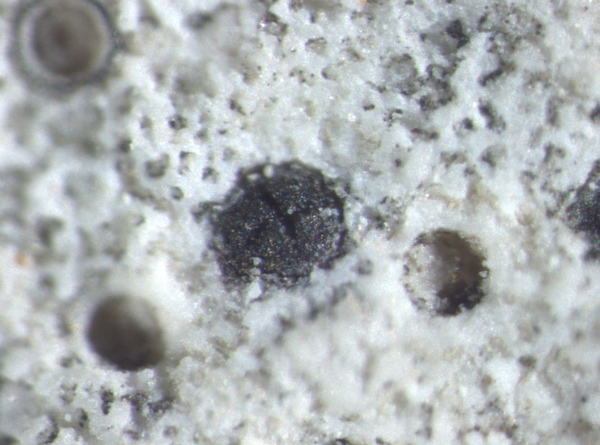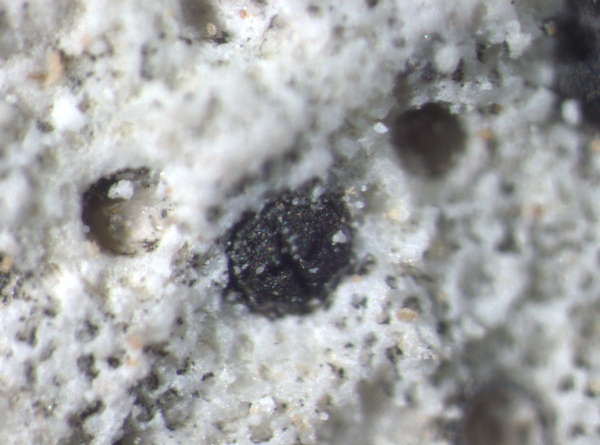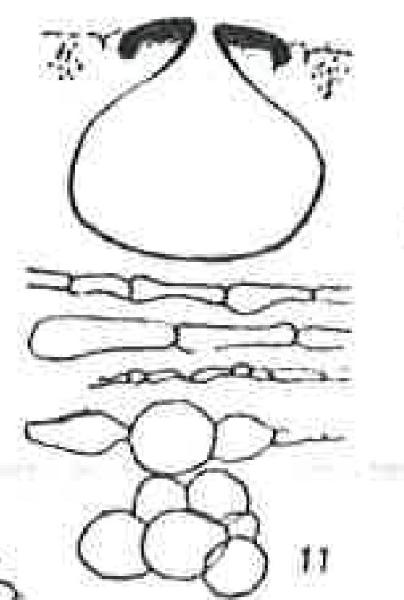Bagliettoa parmigerella (Zahlbr.) Vězda & Poelt
in Poelt & Vezda, Bibl. Lichenol., 16: 363, 1981. Basionym: Verrucaria parmigerella Zahlbr. - Österr. bot. Z., 68: 64, 1919.
Synonyms: Protobagliettoa bagliettoaeformis (Hazsl.) Servít; Protobagliettoa erumpens (Servít) Servít; Protobagliettoa parmigerella (Zahlbr.) Servít; Verrucaria harrimannii sensu Anzi; Verrucaria pinguis J. Steiner; Verrucaria sphinctrinella var. italica Servít; Verrucaria sphinctrinella Zschacke
Description: Thallus crustose, fully endosubstratic, usually covering large surfaces, grey-green or blue-green, sometimes dark lead-grey with a greenish tinge, often slightly glossy, uncracked. Cortex (lithocortex) densely prosoplectenchymatous, of conglutinated hyphae intermingled with microcrystals, with a green pigment; algal layer discontinuous, photobiont cells in clusters; medulla prosoplectenchymatous, sometimes with oil cells (macrosphaeroids) in the lower part. Perithecia black, completely immersed in the rock and leaving deep pits when they fall off. Involucrellum black, flat to slightly convex, much narrower than the body of the perithecium (0.15-0.22 μm diam.), spreading sideways but scarcely downwards, in surface view usually with 3-6 fine cracks radiating from ostiole (the cracks may be poorly evident or even absent in some specimens); exciple 0.2-0.3 mm across, the wall colourless to pale brown; hymenial gel hemiamyloid, I+ red (I+ blue at very low concentrations of I), K/I+ blue; hamathecium of periphyses in the ostiolar canal, and short periphysoids in the upper half of the perithecial cavity; paraphyses dissolving early. Asci 8-spored, two-layered, fissitunicate, with a thin tholus reacting I-, Verrucaria-type. Ascospores 1-celled, hyaline, ellipsoid, often poorly developed, 14-21(-25) x 6-8(-12) μm. Photobiont chlorococcoid. Spot tests: K-, C-, KC-, P-, UV-. Chemistry: without lichen substances.
Growth form: Crustose endolithic
Substrata: rocks
Photobiont: green algae other than Trentepohlia
Reproductive strategy: mainly sexual
Commonnes-rarity: (info)
Alpine belt: absent
Subalpine belt: extremely rare
Montane belt: very common
Dry submediterranean belt: common
Humid submediterranean belt: common
Padanian area: very rare
pH of the substrata:
1 2 3 4 5
Solar irradiation:
1 2 3 4 5
Aridity:
1 2 3 4 5
Eutrophication:
1 2 3 4 5
Poleotolerance:
0 1 2 3
Altitudinal distribution:
1 2 3 4 5 6
Rarity
absent
extremely rare
very rare
rare
rather rare
rather common
common
very common
extremely common
Loading data...
Occurrence data
Predictive map
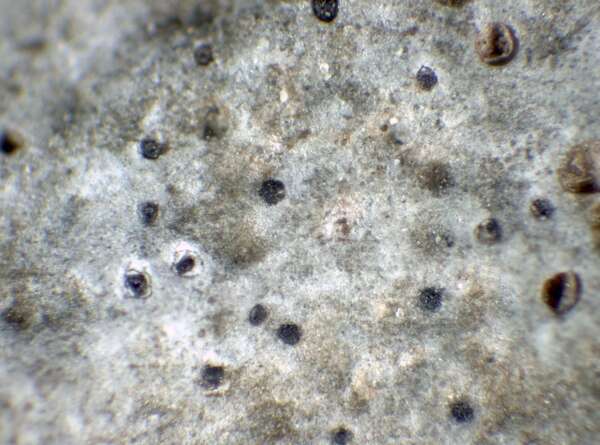
P.L. Nimis; Owner: Department of Life Sciences, University of Trieste
Herbarium: TSB (32393)
2001/12/09
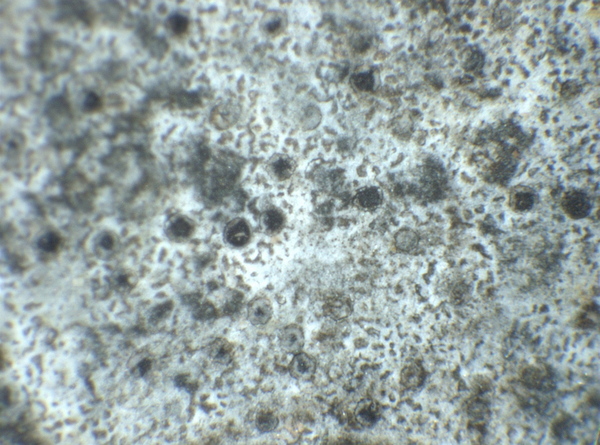
P.L.Nimis; Owner: Department of Life Sciences, University of Trieste
Herbarium: TSB (38166)
2008.02.23
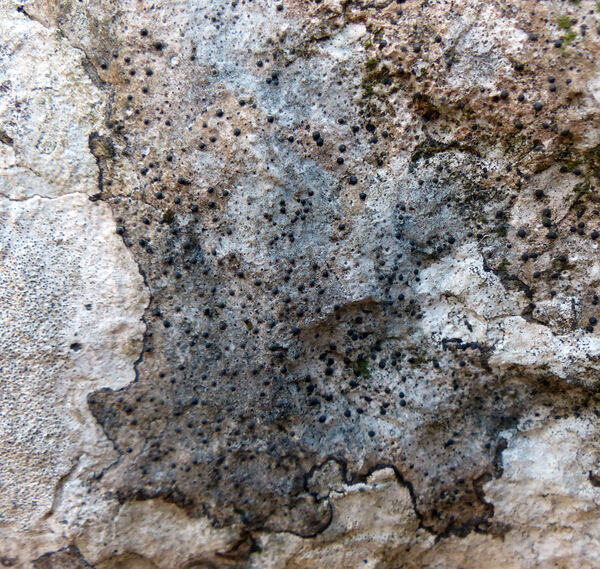
Andrea Moro; Owner: Department of Life Sciences, University of Trieste
italy, Friuli Venezia Giulia, Trieste, Trieste Karst near Borgo Grotta Gigante
16/02/2017
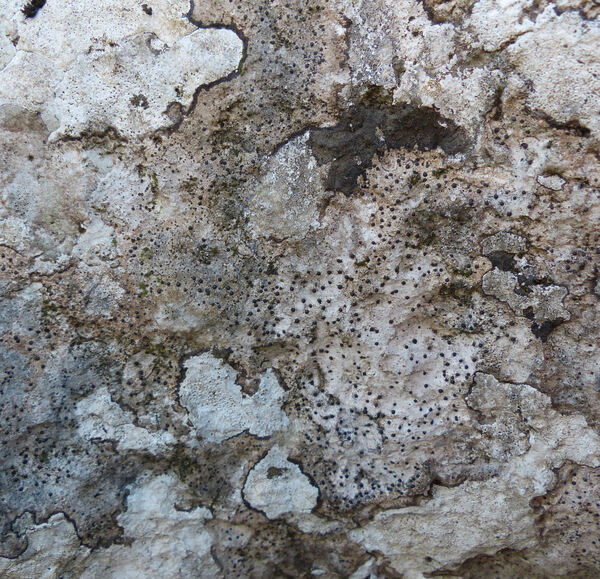
Andrea Moro; Owner: Department of Life Sciences, University of Trieste
italy, Friuli Venezia Giulia, Trieste, Trieste Karst near Borgo Grotta Gigante
16/02/2017
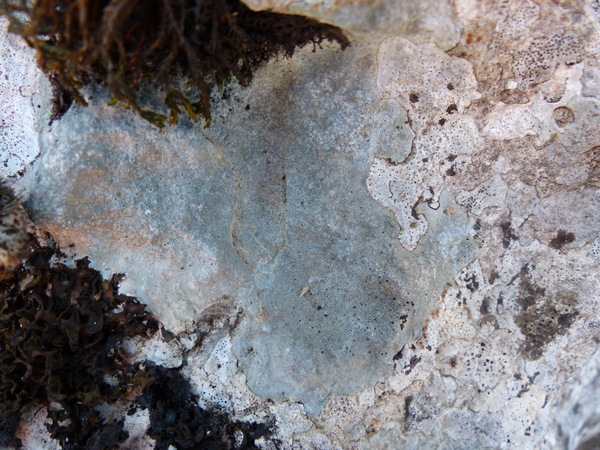
Andrea Moro; Owner: Department of Life Sciences, University of Trieste
italy, Friuli Venezia Giulia, Trieste, Trieste Karst near Borgo Grotta Gigante
16/02/2017
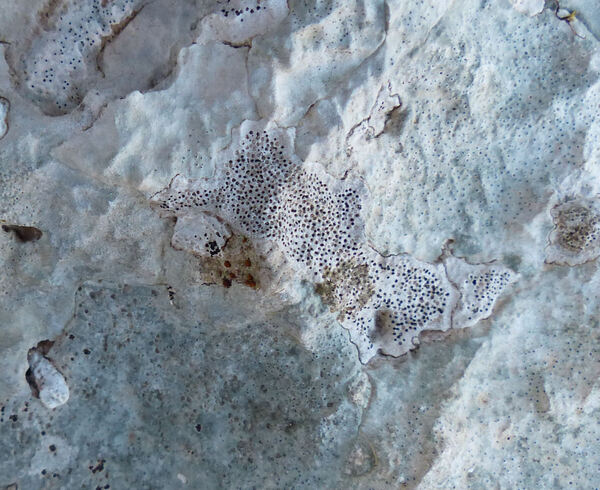
Andrea Moro; Owner: Department of Life Sciences, University of Trieste
italy, Friuli Venezia Giulia, Trieste, Trieste Karst near Borgo Grotta Gigante
16/02/2017
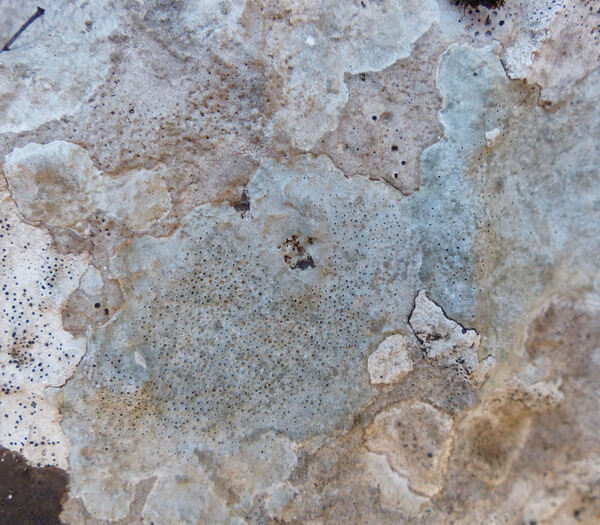
Andrea Moro; Owner: Department of Life Sciences, University of Trieste
italy, Friuli Venezia Giulia, Trieste, Trieste Karst near Borgo Grotta Gigante
16/02/2017
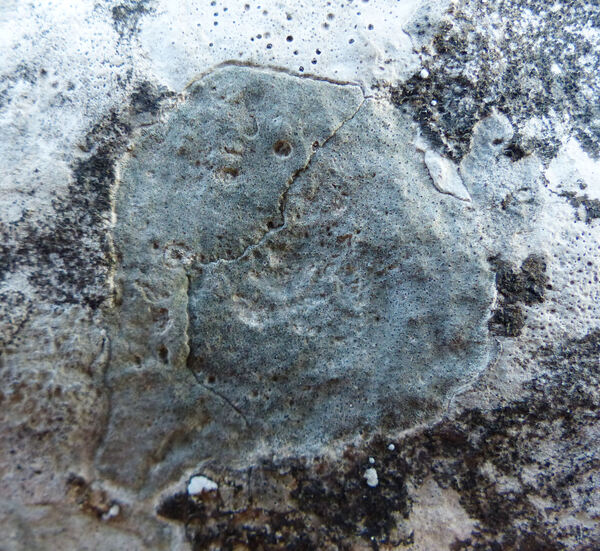
Andrea Moro; Owner: Department of Life Sciences, University of Trieste
italy, Friuli Venezia Giulia, Trieste, Trieste Karst near Borgo Grotta Gigante
16/02/2017

Andrea Moro; Owner: Department of Life Sciences, University of Trieste
italy, Friuli Venezia Giulia, Trieste, Trieste Karst near Borgo Grotta Gigante
16/02/2017
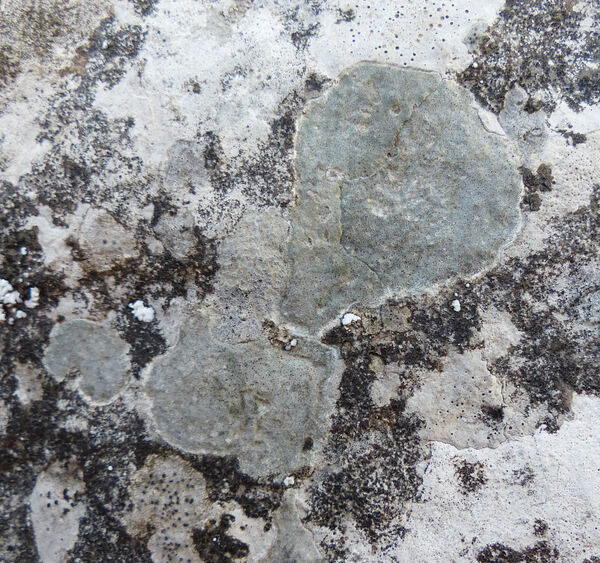
Andrea Moro; Owner: Department of Life Sciences, University of Trieste
italy, Friuli Venezia Giulia, Trieste, Trieste Karst near Borgo Grotta Gigante
16/02/2017
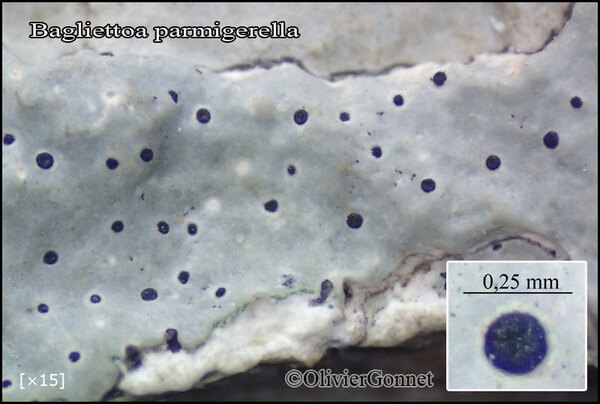
Courtesy Danièle et Olivier Gonnet - Source: https://www.afl-lichenologie.fr/Photos_AFL/Photos_AFL_B/Bagliettoa_parmigerella.htm
France, Lioux - Vaucluse - (84) - sur la falaise de la Madeleine, alt. 320 m
22/05/2017
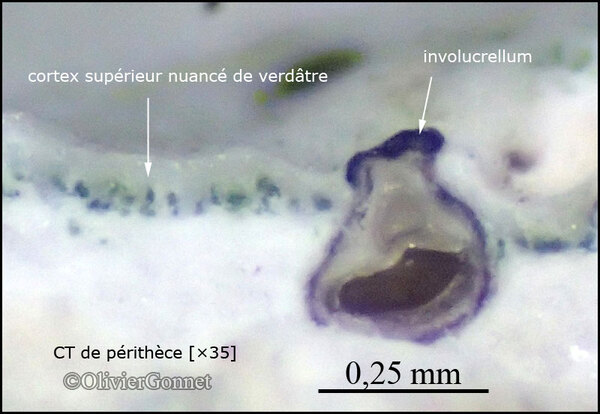
Courtesy Danièle et Olivier Gonnet - Source: https://www.afl-lichenologie.fr/Photos_AFL/Photos_AFL_B/Bagliettoa_parmigerella.htm
France, Lioux - Vaucluse - (84) - sur la falaise de la Madeleine, alt. 320 m
22/05/2017
Growth form: Crustose endolithic
Substrata: rocks
Photobiont: green algae other than Trentepohlia
Reproductive strategy: mainly sexual
Commonnes-rarity: (info)
Alpine belt: absent
Subalpine belt: extremely rare
Montane belt: very common
Dry submediterranean belt: common
Humid submediterranean belt: common
Padanian area: very rare
pH of the substrata:
| 1 | 2 | 3 | 4 | 5 |
Solar irradiation:
| 1 | 2 | 3 | 4 | 5 |
Aridity:
| 1 | 2 | 3 | 4 | 5 |
Eutrophication:
| 1 | 2 | 3 | 4 | 5 |
Poleotolerance:
| 0 | 1 | 2 | 3 |
Altitudinal distribution:
| 1 | 2 | 3 | 4 | 5 | 6 |
Rarity
absent
extremely rare
very rare
rare
rather rare
rather common
common
very common
extremely common
Loading data...
Occurrence data
Predictive map

P.L. Nimis; Owner: Department of Life Sciences, University of Trieste
Herbarium: TSB (32393)
2001/12/09

P.L.Nimis; Owner: Department of Life Sciences, University of Trieste
Herbarium: TSB (38166)
2008.02.23

Andrea Moro; Owner: Department of Life Sciences, University of Trieste
italy, Friuli Venezia Giulia, Trieste, Trieste Karst near Borgo Grotta Gigante
16/02/2017

Andrea Moro; Owner: Department of Life Sciences, University of Trieste
italy, Friuli Venezia Giulia, Trieste, Trieste Karst near Borgo Grotta Gigante
16/02/2017

Andrea Moro; Owner: Department of Life Sciences, University of Trieste
italy, Friuli Venezia Giulia, Trieste, Trieste Karst near Borgo Grotta Gigante
16/02/2017

Andrea Moro; Owner: Department of Life Sciences, University of Trieste
italy, Friuli Venezia Giulia, Trieste, Trieste Karst near Borgo Grotta Gigante
16/02/2017

Andrea Moro; Owner: Department of Life Sciences, University of Trieste
italy, Friuli Venezia Giulia, Trieste, Trieste Karst near Borgo Grotta Gigante
16/02/2017

Andrea Moro; Owner: Department of Life Sciences, University of Trieste
italy, Friuli Venezia Giulia, Trieste, Trieste Karst near Borgo Grotta Gigante
16/02/2017

Andrea Moro; Owner: Department of Life Sciences, University of Trieste
italy, Friuli Venezia Giulia, Trieste, Trieste Karst near Borgo Grotta Gigante
16/02/2017

Andrea Moro; Owner: Department of Life Sciences, University of Trieste
italy, Friuli Venezia Giulia, Trieste, Trieste Karst near Borgo Grotta Gigante
16/02/2017

Courtesy Danièle et Olivier Gonnet - Source: https://www.afl-lichenologie.fr/Photos_AFL/Photos_AFL_B/Bagliettoa_parmigerella.htm
France, Lioux - Vaucluse - (84) - sur la falaise de la Madeleine, alt. 320 m
22/05/2017



